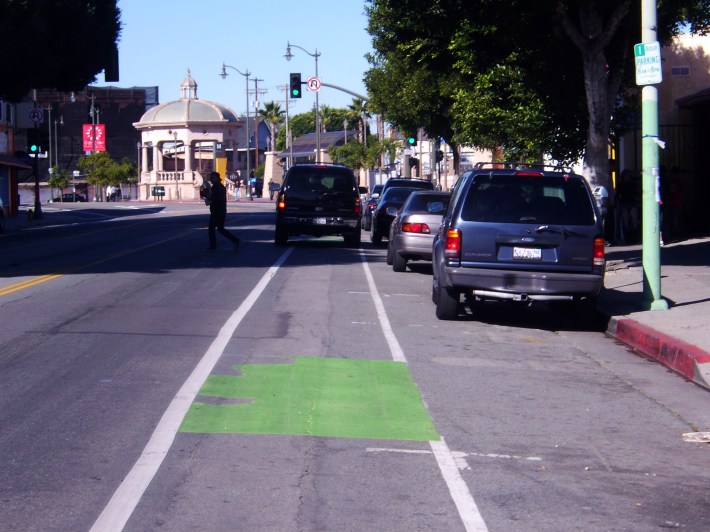Behold the 1st Street Bike Lanes! Now Where Was the Outreach?
9:55 AM PST on February 3, 2012
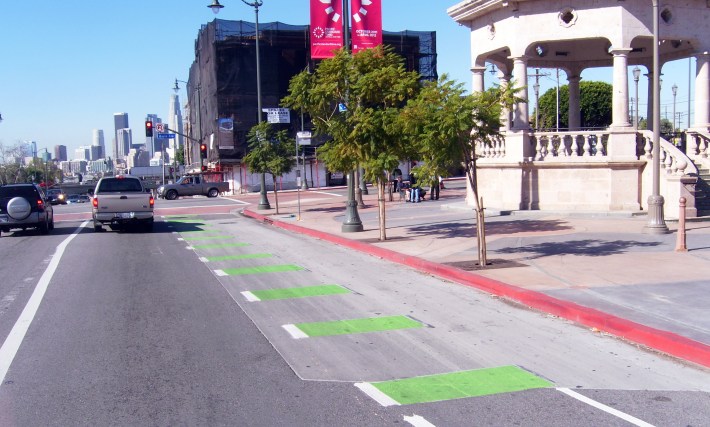
Bike lanes began to appear in Boyle Heights during November 2011. It was a joyous celebratory occasion to many cycling advocates who have lobbied city hall for years. The lobbying is a result of several thousand incidents throughout the city in which cyclists have been involved in automobile traffic collisions. These incidents have resulted in property damage, personal injury, and tragically, death.
Politicos hold press conferences announcing the new bike lanes as they are painted in each district throughout the city. They jump on a bike, ride for a block or so for the perfect photo opportunity. After the picture has been taken, they walk away from the project, and it's "Mission Accomplished!"
Well, not really..... I started to receive phone calls and emails from Boyle Heights residents asking questions as soon as the paint was dry on the new 1st Street Bike Lanes, part of which are painted green. These calls were mostly concerned with how to maneuver around the new bike lanes. This did not surprise me, as a matter of fact, I was expecting them. The simple reason is that there has been NO outreach or educational material distributed about bike lanes to our community. Like magic, the bike lanes simply appeared. After receiving these many calls in November, I rode over to observe for myself. I witnessed near misses between pedestrians, cyclists and motorists around the bike lane.
In preparing for this article, I revisited First Street in Boyle Heights, where I witnessed the close calls. First Street has about 1.5 miles of bikes lanes that run past the Mariachi Plaza and the Metro Eastside Gold Line. I observed a couple interesting incidents. The first was a car double parked in the bike lane. I pulled out my camera to document it, and as I approached the car to speak with the driver, he drove off. This is a big problem. Cyclists often find obstacles such as cars, trash cans and debris thrown in the bike lanes.
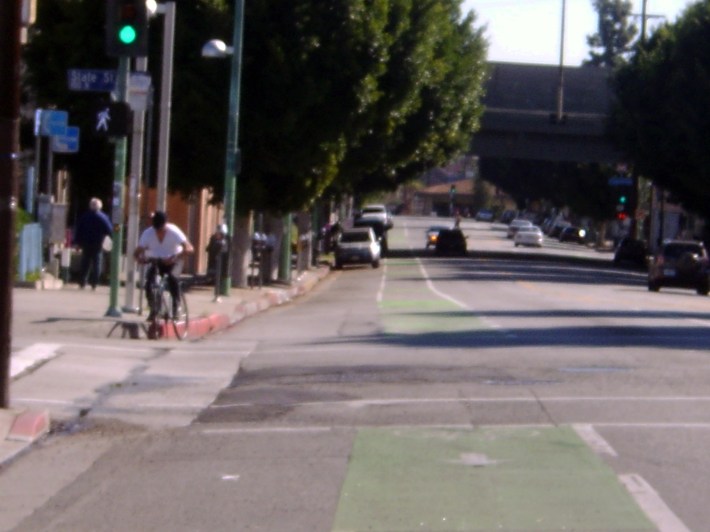
Next, I saw was a couple of cyclists who veered over from the bike lane to the curb while waiting for a green light at the intersection of First and State Street. First, I thought it was an isolated incident, then a couple of minutes later, I noticed another cyclist doing it, a few minutes later, yet another one. This actually puts the cyclist at a greater risk and into a “Danger Zone” by placing them in the way of a vehicle making a right turn. When the light turned green, each cyclist would veer back into the bike lane position while pedaling through the intersection. This can be another dangerous maneuver which places the cyclist in danger.
Last, I noticed pedestrians crossing bike lanes often talking, surfing the ‘net, chatting and texting on their cell phones. They are not paying attention to the stripes on the ground. This should be a concern because this is where pedestrians, bikes and automobiles all meet on the street, all sharing the road.
During this trip I also met Juan Romero, owner of Primera Taza Coffee House and asked him what he thought of the bike lanes. Romero said, “I think it’s a great start, not only for businesses here in our community but also for residents. They (cyclists) are now able to utilize these lanes as a safe pathway to run errands or go to school or work. One of the problems we have in Boyle Heights is the mix of bikers and foot traffic on the sidewalk. I have seen lots of near misses with people walking in and out of businesses. Now that the bike lanes are in place, I hope more cyclists will try to use them and clear room on the sidewalk for pedestrians. It’s nice to see entire families riding in the lanes and even better when everyone is wearing a helmet.”
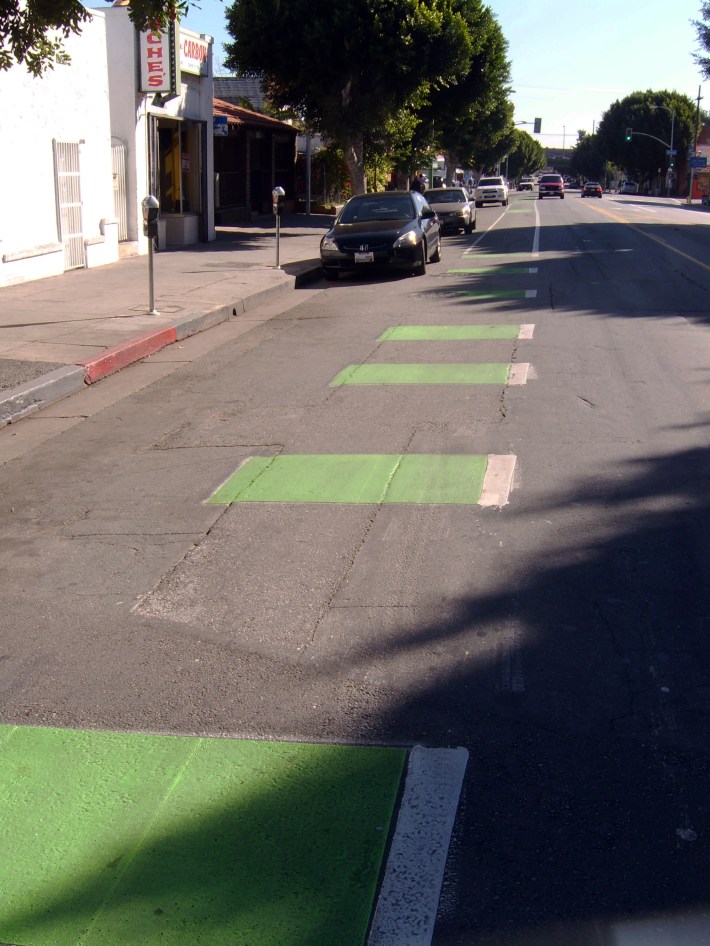
Romero asked me, “Why the discrepancy of the Green bike lanes in downtown Los Angeles (DTLA), and the ones we have here in Boyle Heights?” What Romero was referring to is that in DTLA, the bike lanes are printed solid green, and in Boyle Heights lanes are outlined with lines with partially painted green sections. LADOT officials have noted that in DTLA, there are less driveways and alley ways where vehicles can pull in and out. In contrast to the Boyle Heights community, there are many businesses and residences with narrow driveways and numerous alleyways. The green stripes are there to warn both cyclists and motorists, these are “Danger Zones.” The green stripes are also found at all intersections by the crosswalks.
A common problem in this city and across the state; is many cyclists are teens or possibly day laborers. They do not own a driver’s license, or perhaps never obtained one, yet they are expected to obey the same rules of the road as a motor vehicle. Most of these people have never seen a Department of Motor Vehicles (DMV) manual, which is referred to when preparing for a driver’s license to operate a motor vehicle, and learn the “Rules of the Road.”

I picked up the 2011 CA DMV Manuel just to see what it says about bike lanes. This section does not seem to have been updated, and does not mention or include photos or diagrams of green bike lanes.
Below is a snippet of actual verbiage out of the CALIFORNIA DRIVER HANDBOOK 2011 Edition:
Bicycle lanes: A bicycle lane is a designated traffic lane for bicyclists, marked by a solid white line, typically breaking into a dotted line at the corner. Different from a simple white line showing the edge of the road, a bicycle lane follows specific width requirements and is clearly marked as a bike lane.
Share the Roadway Bicycle markings (sharrows)
Sharrows are used to remind motorists that bicyclists are allowed to lawfully use this portion of a lane. Sharrows are used to assist bicyclists with positioning on a shared roadway. It also alerts motorists of the location a bicyclist may occupy within the traveled roadway.
- Treat a bicycle lane the same as other traffic lanes.
- Do not turn into the lane if there is a bicyclist in the bike lane. Yield to oncoming traffic.
- Do not obstruct bicycle traffic by reducing the width required for safe bicycle passage, typically three to four feet. When you are making a right turn and are within 200 feet of the corner or other driveway entrance, you must enter the bicycle lane only after en- suring there is no bicycle traffic, and then make the turn. Do not drive in the bicycle lane at any other time.
Bicyclists have the same rights and responsibilities as vehicle and motorcycle drivers. Respect the right of way of bicyclists because they are entitled to share the road with other drivers.
Personally, I find the bike lane section to be very vague and outdated. It does not mention pedestrians in bike lanes, and does not mention or have photos of the green bike lanes.
What bike planners and city officials are missing is an integral cohesive education and outreach plan, supported with visible signage to address motorists, cyclists and pedestrians. Signs should be posted on poles along the road and sidewalk where the bike path is located. It should address pedestrians, cyclists and motorists. Outreach should also be done at schools, city parks, libraries, businesses or resident homes. Signage should address blocking of bike lanes (cars / trash cans / dumping of debris), Texting/Chatting/Surfing/Talking while walking near the lanes. Not just “SHARE THE ROAD” and “BIKE LANE”
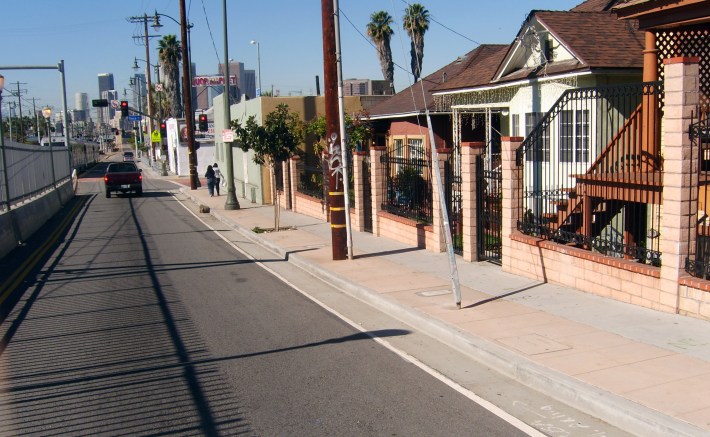
There are two good examples of public outreach from the government on local projects here in Boyle Heights. The first is the Metro Gold Line Eastside Extension. Prior to becoming operational, Metro launched a public safety outreach and education campaign through flyers, newspaper ads, several public meetings, and press conferences, all aimed at the community public safety concerns. They also made presentations at schools, Neighborhood Watch meetings, Chambers of Commerce mixers, Neighborhood Council meetings, parks, libraries, and passed out literature to businesses and homes. When the Gold Line became operational, Metro launched another outreach and education campaign to make sure the community understands the severity of possible dangers.
The second example is the campaign utilized prior to LA distributing the three trash collection and recycling bins (Black, Green and Blue) to city residents. This outreach and education campaign was established to alert stakeholders on what items were to be deposited in each colored container. When the containers were delivered, the city informed stakeholders by attaching flyers on the collection bins to ensure the community understands the proper use of these containers. There were also press conferences and pamphlets passed out at Neighborhood Councils, Senior Centers, Libraries, and Neighborhood Watch meetings.
What will it take for city officials to take a proactive approach, and move forward to outreach and educate our community of the importance of bikes lanes? We have only begun to see the first 100 miles of the proposed 1,600 miles of bike infrastructure. Let’s solve the problem now before another community member gets hurt or killed.
Carlos Morales' weekly column is sponsored by the law firm of Gordon, Edelstein, Krepack, Grant, Felton & Goldstein, LLP.
Stay in touch
Sign up for our free newsletter
More from Streetsblog Los Angeles
Metro Board Funds Free Student Transit Pass Program through July 2025
Metro student free passes funded another year - plus other updates from today's Metro board meeting
Eyes on the Street: New Lincoln Park Avenue Bike Lanes
The recently installed 1.25-mile long bikeway spans Lincoln Park Avenue, Flora Avenue, and Sierra Street - it's arguably the first new bike facility of the Measure HLA era
